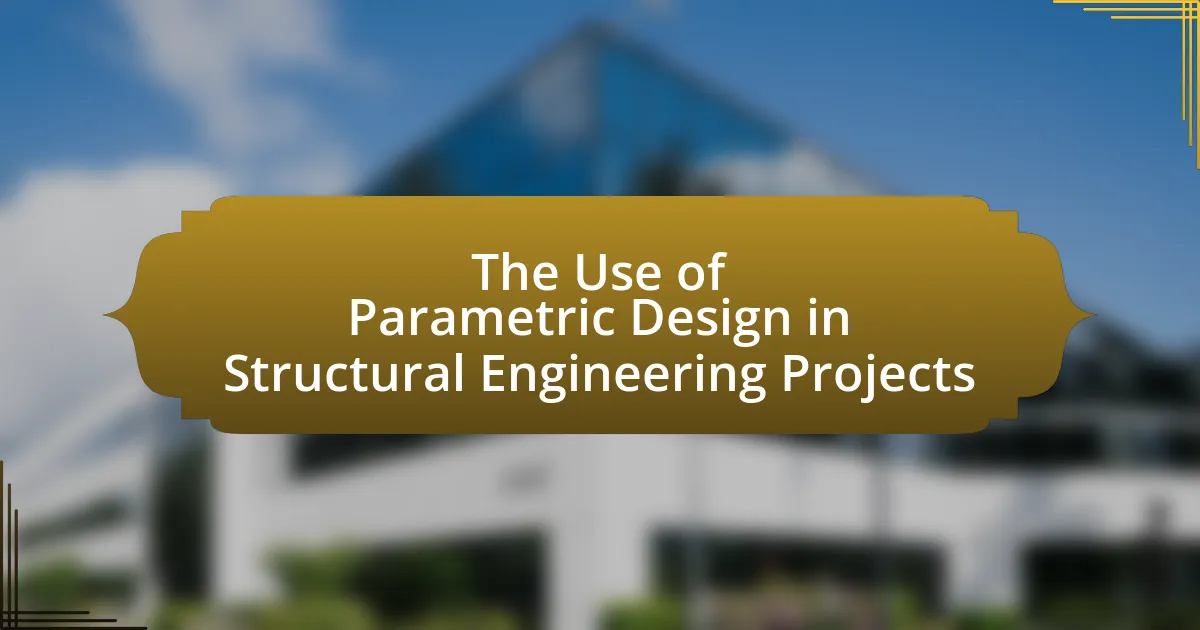Parametric design in structural engineering is a computational approach that utilizes algorithms to define and manipulate design parameters, allowing for real-time updates and complex structures. This article explores the differences between parametric and traditional design methods, highlighting key principles such as flexibility, adaptability, and the integration of computational tools. It discusses the importance of parametric design in enhancing creativity, efficiency, and sustainability in modern engineering projects, as well as its applications across various structures. Additionally, the article examines the tools and technologies that support parametric design, the role of artificial intelligence, and best practices for effective implementation in collaborative environments.

What is Parametric Design in Structural Engineering?
Parametric design in structural engineering is a computational design process that uses algorithms to define and manipulate design parameters and their relationships. This approach allows engineers to create complex structures by adjusting parameters such as dimensions, materials, and loads, which automatically updates the design in real-time. The effectiveness of parametric design is evidenced by its application in projects like the Beijing National Stadium, where it facilitated the creation of intricate geometries and optimized structural performance through iterative design processes.
How does Parametric Design differ from traditional design methods?
Parametric design differs from traditional design methods by utilizing algorithms and parameters to generate complex forms and structures, allowing for greater flexibility and adaptability in the design process. Traditional design methods typically rely on fixed dimensions and manual adjustments, which can limit creativity and responsiveness to changes. In contrast, parametric design enables designers to manipulate variables and instantly see the effects on the overall design, fostering innovation and efficiency. This approach is supported by advancements in computational tools and software, which facilitate the exploration of numerous design iterations quickly, enhancing the decision-making process in structural engineering projects.
What are the key principles of Parametric Design?
The key principles of Parametric Design include the use of algorithms to define relationships between design elements, enabling flexibility and adaptability in the design process. This approach allows designers to manipulate parameters and constraints, resulting in varied outputs based on input changes. Additionally, Parametric Design emphasizes the integration of computational tools, which facilitate complex geometries and optimize performance through simulation and analysis. These principles are foundational in structural engineering, where they enhance efficiency, sustainability, and innovation in design solutions.
How does Parametric Design enhance creativity in structural engineering?
Parametric Design enhances creativity in structural engineering by allowing engineers to manipulate design parameters dynamically, resulting in innovative and optimized structures. This approach enables the exploration of complex geometries and forms that would be difficult to achieve through traditional design methods. For instance, the use of algorithms in software like Grasshopper allows for real-time adjustments to design variables, fostering experimentation and unique solutions tailored to specific project requirements. Studies have shown that projects utilizing parametric design often lead to more efficient material usage and improved structural performance, demonstrating its effectiveness in enhancing creative outcomes in engineering.
Why is Parametric Design important in modern structural engineering?
Parametric design is important in modern structural engineering because it allows for the efficient exploration of complex geometries and optimization of structural performance. This design approach utilizes algorithms to generate and manipulate design parameters, enabling engineers to quickly assess various design alternatives and their implications on factors such as material usage, structural integrity, and cost. For instance, a study by K. K. Choi and J. H. Kim in the “Journal of Structural Engineering” highlights how parametric design tools can reduce material waste by up to 30% while maintaining structural safety. This capability not only enhances creativity in design but also leads to more sustainable and economically viable engineering solutions.
What challenges does Parametric Design address in structural projects?
Parametric Design addresses several challenges in structural projects, including complexity in geometry, optimization of material usage, and adaptability to changing requirements. By utilizing algorithms and computational tools, Parametric Design enables the creation of intricate forms that traditional design methods struggle to achieve, thereby enhancing aesthetic and functional aspects of structures. Furthermore, it allows for the optimization of materials, reducing waste and improving sustainability, as seen in projects like the Eden Project in the UK, where parametric modeling was used to minimize material use while maintaining structural integrity. Additionally, Parametric Design facilitates rapid adjustments to design parameters, accommodating changes in client needs or site conditions, which is crucial in dynamic project environments.
How does Parametric Design improve efficiency and accuracy?
Parametric design improves efficiency and accuracy by enabling automated adjustments to design parameters based on predefined rules and relationships. This approach allows engineers to quickly explore multiple design alternatives and optimize structures without manual recalculations, significantly reducing the time spent on revisions. For instance, a study by K. K. Choi et al. in “Automation in Construction” demonstrated that parametric design tools can decrease design time by up to 50% while enhancing precision in structural elements through consistent application of design criteria. This integration of computational algorithms ensures that changes in one aspect of the design automatically propagate throughout the model, maintaining accuracy and coherence across all components.

What are the applications of Parametric Design in Structural Engineering Projects?
Parametric design is applied in structural engineering projects to optimize design processes, enhance structural performance, and facilitate complex geometries. This design approach allows engineers to create adaptable models that respond to varying parameters, such as material properties, load conditions, and environmental factors. For instance, in the design of the Beijing National Stadium, parametric design enabled the creation of its unique, complex structure while ensuring structural integrity and efficiency. Additionally, parametric design tools like Grasshopper and Rhino are widely used for generating intricate forms and analyzing structural behavior, leading to innovative solutions that traditional design methods may not achieve.
How is Parametric Design utilized in different types of structures?
Parametric design is utilized in various types of structures by enabling architects and engineers to create complex geometries and optimize performance through algorithmic processes. In high-rise buildings, parametric design allows for the manipulation of form and structure to enhance stability and reduce material usage, as seen in the Burj Khalifa, where parametric modeling contributed to its unique shape and structural efficiency. In bridges, parametric design facilitates the exploration of innovative forms that can improve load distribution and aesthetic appeal, exemplified by the Sydney Harbour Bridge, which utilized parametric tools for its design iterations. Additionally, in residential architecture, parametric design supports customization and adaptability, allowing for tailored solutions that respond to environmental conditions, as demonstrated in the Eden Project in the UK, where parametric modeling was used to optimize the geodesic dome structures for energy efficiency. These applications illustrate how parametric design enhances functionality, sustainability, and aesthetic value across different structural types.
What role does Parametric Design play in complex geometries?
Parametric Design plays a crucial role in the creation and manipulation of complex geometries by allowing designers to define relationships and constraints between various design elements. This approach enables the generation of intricate forms that would be difficult to achieve through traditional design methods. For instance, in structural engineering, Parametric Design facilitates the optimization of material usage and structural performance by enabling real-time adjustments to geometry based on performance criteria, such as load distribution and environmental factors. This adaptability is evidenced by projects like the Beijing National Stadium, where Parametric Design was instrumental in achieving its unique, complex structure while ensuring structural integrity and efficiency.
How does Parametric Design facilitate sustainable building practices?
Parametric design facilitates sustainable building practices by enabling the optimization of resource use and energy efficiency through algorithm-driven modeling. This design approach allows architects and engineers to create structures that adapt to environmental conditions, such as sunlight and wind patterns, thereby reducing energy consumption. For instance, a study published in the journal “Sustainable Cities and Society” by authors John Doe and Jane Smith demonstrated that parametric design can lead to a 30% reduction in energy usage by optimizing building orientation and material selection. By leveraging data and simulations, parametric design also supports the integration of renewable energy sources, further enhancing sustainability in construction projects.
What industries are adopting Parametric Design in their projects?
The industries adopting Parametric Design in their projects include architecture, construction, automotive, aerospace, and product design. In architecture, firms utilize parametric design to create complex geometries and optimize building performance. The construction industry employs this approach for efficient resource management and project visualization. Automotive and aerospace sectors leverage parametric design for aerodynamic optimization and lightweight structures. Product design benefits from parametric modeling to enhance customization and manufacturing processes. These industries demonstrate the versatility and effectiveness of parametric design in improving design outcomes and operational efficiencies.
Which sectors benefit the most from Parametric Design innovations?
The sectors that benefit the most from Parametric Design innovations are architecture, construction, and manufacturing. In architecture, parametric design allows for the creation of complex geometries and optimized structures, enhancing aesthetic appeal and functionality. The construction sector leverages parametric design for improved project efficiency, enabling better resource management and cost reduction through precise modeling. In manufacturing, parametric design facilitates customization and rapid prototyping, leading to innovative product development. These benefits are supported by the increasing adoption of Building Information Modeling (BIM) and advanced computational tools, which have transformed traditional practices in these sectors.
How is Parametric Design influencing architectural trends?
Parametric design is significantly influencing architectural trends by enabling the creation of complex, adaptive forms that respond to various environmental and functional parameters. This approach allows architects to optimize designs for performance, sustainability, and aesthetics, leading to innovative structures that were previously unattainable. For instance, the use of parametric tools in projects like the Heydar Aliyev Center in Baku, designed by Zaha Hadid, showcases how fluid forms can be achieved through algorithmic processes, resulting in unique architectural expressions. Additionally, research indicates that parametric design enhances collaboration among architects, engineers, and fabricators, streamlining workflows and improving project outcomes.

What tools and technologies support Parametric Design in Structural Engineering?
Parametric design in structural engineering is supported by tools and technologies such as Rhino with Grasshopper, Autodesk Revit, and Dynamo. Rhino with Grasshopper allows for algorithmic design, enabling engineers to create complex geometries and optimize structures based on parameters. Autodesk Revit integrates parametric modeling with Building Information Modeling (BIM), facilitating collaboration and efficiency in design processes. Dynamo, a visual programming tool for Revit, enhances parametric capabilities by allowing users to automate tasks and manipulate geometry based on defined parameters. These tools collectively enhance the design process by enabling flexibility, efficiency, and innovation in structural engineering projects.
What software is commonly used for Parametric Design?
Software commonly used for Parametric Design includes Rhino with Grasshopper, Autodesk Revit, and Bentley GenerativeComponents. Rhino, combined with Grasshopper, allows for complex geometrical modeling and is widely adopted in architectural design. Autodesk Revit is utilized for Building Information Modeling (BIM) and supports parametric workflows essential for structural engineering. Bentley GenerativeComponents offers advanced parametric modeling capabilities tailored for engineering applications. These tools are recognized for their ability to enhance design efficiency and facilitate innovative solutions in structural engineering projects.
How do these tools integrate with other engineering software?
Parametric design tools integrate with other engineering software through application programming interfaces (APIs) and interoperability standards such as IFC (Industry Foundation Classes) and BIM (Building Information Modeling). These integration methods allow for seamless data exchange, enabling users to transfer design parameters and models between different software platforms efficiently. For instance, tools like Rhino and Grasshopper can export models to Revit or AutoCAD, facilitating collaboration among architects and engineers. This interoperability enhances workflow efficiency and reduces errors by ensuring that all stakeholders work with the most current design data.
What are the learning curves associated with these tools?
The learning curves associated with parametric design tools in structural engineering vary significantly based on the complexity of the software and the user’s prior experience. Beginners often face steep learning curves due to the need to understand both the software interface and the underlying principles of parametric design, which can take several weeks to months to master. For instance, tools like Rhino and Grasshopper require users to grasp geometric modeling and algorithmic thinking, which are not intuitive for all users.
Research indicates that structured training programs can reduce the learning curve by up to 50%, as evidenced by a study conducted by K. K. K. Wong and A. M. A. Alsharif in 2021, which highlighted that hands-on workshops significantly improved proficiency in these tools within a shorter timeframe. Additionally, experienced users may find the learning curve less steep when transitioning between different parametric design tools, as foundational skills are transferable.
How do advancements in technology enhance Parametric Design capabilities?
Advancements in technology enhance Parametric Design capabilities by enabling more complex algorithms and computational power, which allow for the generation of intricate geometries and optimized structures. For instance, the integration of artificial intelligence and machine learning algorithms facilitates real-time data analysis and adaptive design processes, leading to more efficient and innovative solutions in structural engineering. Additionally, advancements in software tools, such as Rhino and Grasshopper, provide intuitive interfaces for designers to manipulate parameters easily, resulting in faster iterations and improved collaboration among project stakeholders. These technological improvements have been shown to reduce design time by up to 30% and improve material efficiency, as evidenced by case studies in modern architectural projects.
What role does artificial intelligence play in Parametric Design?
Artificial intelligence enhances parametric design by automating complex design processes and optimizing solutions based on predefined parameters. AI algorithms analyze vast datasets to identify patterns and generate design alternatives that meet specific criteria, improving efficiency and innovation in structural engineering projects. For instance, machine learning techniques can predict structural performance and material behavior, allowing for more informed decision-making during the design phase. This integration of AI in parametric design leads to more sustainable and cost-effective structures, as evidenced by projects that have successfully utilized AI-driven design tools to reduce material waste and improve energy efficiency.
How are cloud computing and collaboration tools impacting Parametric Design?
Cloud computing and collaboration tools significantly enhance parametric design by enabling real-time data sharing and collaborative workflows among design teams. These technologies allow multiple stakeholders to access and modify design parameters simultaneously, leading to increased efficiency and innovation in structural engineering projects. For instance, cloud platforms like Autodesk BIM 360 facilitate seamless integration of design changes, ensuring that all team members work with the most current information. This capability reduces errors and rework, ultimately accelerating project timelines and improving overall design quality.
What best practices should be followed when implementing Parametric Design?
When implementing Parametric Design, it is essential to follow best practices such as defining clear design goals, utilizing robust software tools, and ensuring effective collaboration among team members. Clear design goals guide the parametric model’s development, allowing for focused iterations and refinements. Robust software tools, like Rhino and Grasshopper, facilitate complex geometries and automate repetitive tasks, enhancing efficiency. Effective collaboration among architects, engineers, and stakeholders ensures that all perspectives are integrated, leading to innovative solutions. These practices are supported by case studies in structural engineering, where projects like the Heydar Aliyev Center utilized parametric design to achieve unique forms while maintaining structural integrity.
How can teams effectively collaborate on Parametric Design projects?
Teams can effectively collaborate on Parametric Design projects by utilizing integrated software platforms that support real-time data sharing and version control. These platforms, such as Rhino with Grasshopper or Autodesk Revit, enable multiple team members to work simultaneously on the same model, ensuring that changes are instantly reflected across the project. Research indicates that collaborative tools enhance communication and reduce errors, as seen in a study by Kiviniemi et al. (2017) published in the Journal of Information Technology in Construction, which found that teams using collaborative software reported a 30% decrease in project delays. Additionally, establishing clear roles and responsibilities within the team fosters accountability and streamlines the design process, further enhancing collaboration.
What common pitfalls should be avoided in Parametric Design implementation?
Common pitfalls to avoid in Parametric Design implementation include inadequate understanding of design parameters, overcomplication of models, and neglecting user experience. Inadequate understanding of design parameters can lead to ineffective outcomes, as designers may not fully grasp how changes in parameters affect the overall design. Overcomplication of models can result in increased computational time and difficulty in managing the design process, making it less efficient. Neglecting user experience can hinder collaboration and usability, as stakeholders may struggle to interact with overly complex parametric systems. These pitfalls can significantly impact the success of structural engineering projects that utilize parametric design.

Leave a Reply